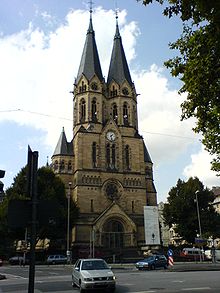Twin tower
The twin tower ( singular ) designates a special type of architecture in architecture , which is characterized by the crowning of a single building with two towers , while twin towers ( plural ) denotes a characteristic ensemble of two towers standing next to each other, which mostly serve other than technical purposes.
The terms “twin towers” and “twin towers” are not used for two towers that are integrated into historical buildings in parts of the building, such as the two gate towers of a castle or the double tower facades of sacred buildings . The latter are either referred to as west towers or differentiated as north and south towers depending on their position in relation to the overall building.
Twin tower (singular)
The singular form “twin tower” is more common for historical buildings. It describes a building that looks like it consists of two towers, for example because it has two points. Are representative of it
- the twin tower of the Ringkirche in Wiesbaden (consecrated in 1894)
- the twin tower of the Nikolaikirche in Berlin . Its towers, placed on top of a compact western building, represent the stylistic counterpart to the harmonious double tower façade that has been widespread as the western façade of churches since the Romanesque period , the towers of which are vertically structured together with the lower structure.
Twin towers (plural)
In modern high-rise construction, the plural form “twin towers” describes a complex of two identical or similar individual buildings. The world's tallest building at times and the World Trade Center in New York City , which was destroyed in the terrorist attacks on September 11, 2001 , achieved greatest fame . The World Trade Center , which was built in 1973 , has been copied several times, albeit in a modified form. For example in the Deutsche Bank towers in Frankfurt am Main, which opened in 1984, or in the Petronas Towers in Kuala Lumpur , Malaysia , completed in 1996, which was also the tallest building in the world from its completion until 2003.
Examples of modern twin towers are or were:
in Europe:
- Berlin-Treptow : TwinTowers on the Spree
- Frankfurt am Main : Deutsche Bank skyscraper
- London - Wembley : Wembley Stadium (previous building from 1924, destroyed)
- Paris - La Défense : twin towers of the Société Générale
- Vienna : Vienna Twin Tower on Wienerberg
- Dnipro : Tower residential complex
outside of Europe:
- Bahrain : Dual Towers
- Dubai , United Arab Emirates : Emirates Park Towers
- Kuala Lumpur , Malaysia : Petronas Towers
- Mumbai , India : The Imperial (under construction)
- New York City , USA : Time Warner Center
- New York City, USA: World Trade Center (destroyed)
- New York City, USA: American Copper Buildings
- Santa Cruz de Tenerife , Spain: Torres de Santa Cruz
Other double towers
Twin towers are not only used in high-rise construction and in the construction of representative buildings. For purely technical purposes, characteristic tower twins were built at numerous locations, which were implemented in all construction methods common in tower construction, both with and without connecting elements between the structures. Most of these constructions are used as transmission towers or overhead line masts. A lookout tower designed as a twin tower is the Schönberg tower in Pfullingen.
Twin towers with a rigid connection are usually erected in the form of portal masts or as antenna supports for a large number of antennas that are oriented towards a certain area. Examples of twin towers that are connected with ropes are, for example, the supporting structures of T-antennas or the crossing masts of overhead line crossings of wide rivers and straits, since in both cases two very similar structures are usually used.
Twin towers without rope connections are often used as a two-mast directional antenna for long and medium wave transmitters. The erection of such twin towers as a pure antenna carrier for radio services in the VHF range is rarer, at least in Germany.
Examples of technical twin towers
Twin towers with rigid connection
- Dubai frame
- Torii Tower , Gusborn
- Measuring tower III of the antenna measuring station in Brück
- Guy masts of the Elbe crossing 1
- Schönberg Tower in Pfullingen
Twin towers with wire connection
- T-antenna support towers (for example at the BBC long-wave transmitter in Droitwich )
Twin towers without wire connection
- Long wave transmitter Donebach (LW directional antenna)
- Medium wave transmitter Liblice (MW directional antenna)
- Weiskirchen transmitter (MW directional antenna)
- Gartow transmitter (2 transmission masts for VHF / TV)
gallery
Twin towers of the World Trade Center in New York City , which was destroyed on September 11, 2001
Twin towers in Ramat Gan , Israel
Twin towers of the Petronas Towers in Kuala Lumpur , Malaysia
Twin towers of the Torres de Santa Cruz in Tenerife , Spain
"Siamese Towers" on the San Joaquin campus of the Pontifical Catholic University of Chile









